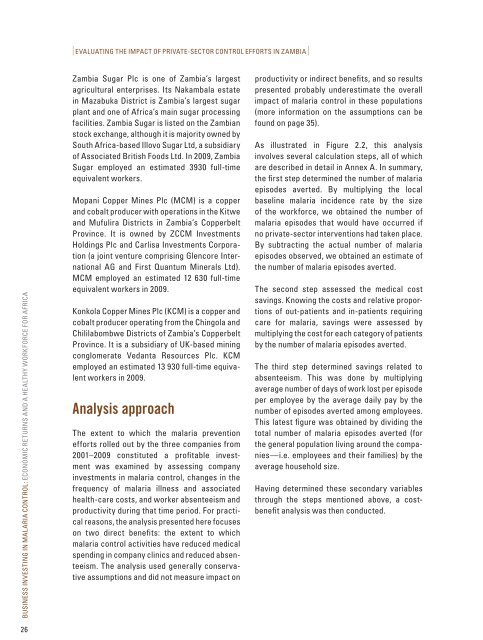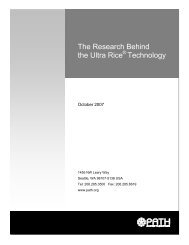Business Investing in Malaria Control: Economic Returns and ... - Path
Business Investing in Malaria Control: Economic Returns and ... - Path
Business Investing in Malaria Control: Economic Returns and ... - Path
Create successful ePaper yourself
Turn your PDF publications into a flip-book with our unique Google optimized e-Paper software.
| EVALUATING THE IMPACT OF PRIVATE-SECTOR CONTROL EFFORTS IN ZAMBIA |<br />
BUSINESS INVESTING IN MALARIA CONTROL: ECONOMIC RETURNS AND A HEALTHY WORKFORCE FOR AFRICA<br />
26<br />
Zambia Sugar Plc is one of Zambia’s largest<br />
agricultural enterprises. Its Nakambala estate<br />
<strong>in</strong> Mazabuka District is Zambia’s largest sugar<br />
plant <strong>and</strong> one of Africa’s ma<strong>in</strong> sugar process<strong>in</strong>g<br />
facilities. Zambia Sugar is listed on the Zambian<br />
stock exchange, although it is majority owned by<br />
South Africa-based Illovo Sugar Ltd, a subsidiary<br />
of Associated British Foods Ltd. In 2009, Zambia<br />
Sugar employed an estimated 3930 full-time<br />
equivalent workers.<br />
Mopani Copper M<strong>in</strong>es Plc (MCM) is a copper<br />
<strong>and</strong> cobalt producer with operations <strong>in</strong> the Kitwe<br />
<strong>and</strong> Mufulira Districts <strong>in</strong> Zambia’s Copperbelt<br />
Prov<strong>in</strong>ce. It is owned by ZCCM Investments<br />
Hold<strong>in</strong>gs Plc <strong>and</strong> Carlisa Investments Corporation<br />
(a jo<strong>in</strong>t venture compris<strong>in</strong>g Glencore International<br />
AG <strong>and</strong> First Quantum M<strong>in</strong>erals Ltd).<br />
MCM employed an estimated 12 630 full-time<br />
equivalent workers <strong>in</strong> 2009.<br />
Konkola Copper M<strong>in</strong>es Plc (KCM) is a copper <strong>and</strong><br />
cobalt producer operat<strong>in</strong>g from the Ch<strong>in</strong>gola <strong>and</strong><br />
Chililabombwe Districts of Zambia’s Copperbelt<br />
Prov<strong>in</strong>ce. It is a subsidiary of UK-based m<strong>in</strong><strong>in</strong>g<br />
conglomerate Vedanta Resources Plc. KCM<br />
employed an estimated 13 930 full-time equivalent<br />
workers <strong>in</strong> 2009.<br />
Analysis approach<br />
The extent to which the malaria prevention<br />
efforts rolled out by the three companies from<br />
2001–2009 constituted a profitable <strong>in</strong>vestment<br />
was exam<strong>in</strong>ed by assess<strong>in</strong>g company<br />
<strong>in</strong>vestments <strong>in</strong> malaria control, changes <strong>in</strong> the<br />
frequency of malaria illness <strong>and</strong> associated<br />
health-care costs, <strong>and</strong> worker absenteeism <strong>and</strong><br />
productivity dur<strong>in</strong>g that time period. For practical<br />
reasons, the analysis presented here focuses<br />
on two direct benefits: the extent to which<br />
malaria control activities have reduced medical<br />
spend<strong>in</strong>g <strong>in</strong> company cl<strong>in</strong>ics <strong>and</strong> reduced absenteeism.<br />
The analysis used generally conservative<br />
assumptions <strong>and</strong> did not measure impact on<br />
productivity or <strong>in</strong>direct benefits, <strong>and</strong> so results<br />
presented probably underestimate the overall<br />
impact of malaria control <strong>in</strong> these populations<br />
(more <strong>in</strong>formation on the assumptions can be<br />
found on page 35).<br />
As illustrated <strong>in</strong> Figure 2.2, this analysis<br />
<strong>in</strong>volves several calculation steps, all of which<br />
are described <strong>in</strong> detail <strong>in</strong> Annex A. In summary,<br />
the first step determ<strong>in</strong>ed the number of malaria<br />
episodes averted. By multiply<strong>in</strong>g the local<br />
basel<strong>in</strong>e malaria <strong>in</strong>cidence rate by the size<br />
of the workforce, we obta<strong>in</strong>ed the number of<br />
malaria episodes that would have occurred if<br />
no private-sector <strong>in</strong>terventions had taken place.<br />
By subtract<strong>in</strong>g the actual number of malaria<br />
episodes observed, we obta<strong>in</strong>ed an estimate of<br />
the number of malaria episodes averted.<br />
The second step assessed the medical cost<br />
sav<strong>in</strong>gs. Know<strong>in</strong>g the costs <strong>and</strong> relative proportions<br />
of out-patients <strong>and</strong> <strong>in</strong>-patients requir<strong>in</strong>g<br />
care for malaria, sav<strong>in</strong>gs were assessed by<br />
multiply<strong>in</strong>g the cost for each category of patients<br />
by the number of malaria episodes averted.<br />
The third step determ<strong>in</strong>ed sav<strong>in</strong>gs related to<br />
absenteeism. This was done by multiply<strong>in</strong>g<br />
average number of days of work lost per episode<br />
per employee by the average daily pay by the<br />
number of episodes averted among employees.<br />
This latest figure was obta<strong>in</strong>ed by divid<strong>in</strong>g the<br />
total number of malaria episodes averted (for<br />
the general population liv<strong>in</strong>g around the companies—i.e.<br />
employees <strong>and</strong> their families) by the<br />
average household size.<br />
Hav<strong>in</strong>g determ<strong>in</strong>ed these secondary variables<br />
through the steps mentioned above, a costbenefit<br />
analysis was then conducted.
















